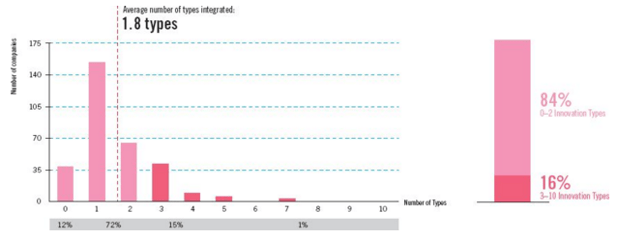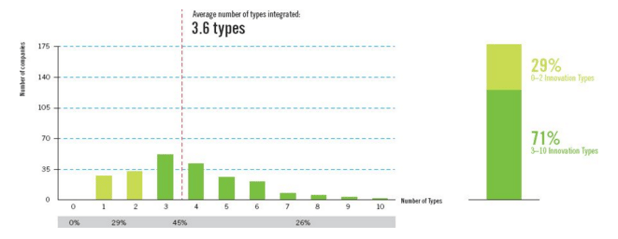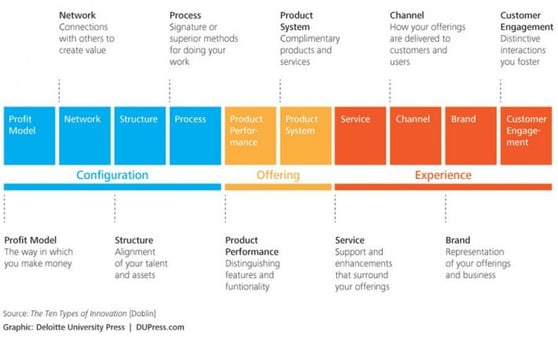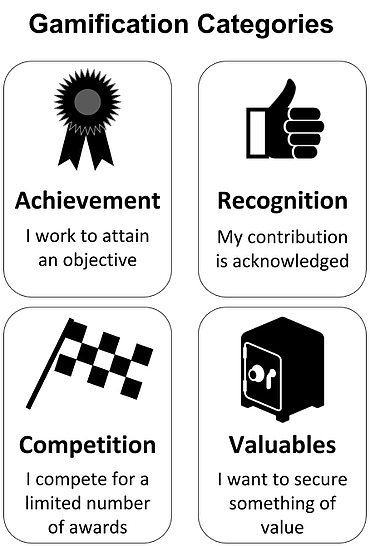Innovation tends to focus around product performance - new products, new updates, new features. That’s why companies often think of R&D investment as the ingredient for innovation. But there’s plenty of innovation to be had in the areas that surround the product. By looking at successful innovators, we can see that they are adept at finding breakthroughs in these surrounding areas. The Ten Types of Innovation is a methodology that is particularly useful at helping us think more broadly, so let’s take a look at how it works.
Since the late 90’s, the Doblin group has been working with the Ten Types framework led by Larry Keeley, President and co-founder of Doblin Inc. Doblin is now part of Deloitte, and the framework has been encapsulated into a book, The Ten Types of Innovation: The Discipline of Building Breakthroughs.
Let’s look at each of the elements in detail.
Profit Model Innovation
The concept of Profit Model Innovation pertains to how an organization generates profit from its value.
Gillette's approach is one innovative example, where they altered their profit model by selling razor handles inexpensively and charging more for the blades. This approach educated consumers that blades are disposable and do not need maintenance.
Another example is Hilti, which offers a subscription service to provide powerful construction tools. This eliminates the need for companies to purchase and maintain expensive equipment.
Network Innovation
Collaboration with others is crucial in creating value through Network Innovation.
In today's interconnected world, it has become increasingly important for companies to work with others to gain access to improved processes, technology, or brand credibility. Open Innovation is a type of Network Innovation that involves utilizing the expertise and skills of individuals outside of one's firm.
An excellent example of this is the US retail corporation Target, which has established a vast network of partnerships, including one with Michael Graves, an architect who designed a line of kitchen appliances.
Structure Innovation
Structural Innovation involves the way you manage the skills and resources within your business. If executed effectively, it can be difficult for competitors to replicate.
W.L. Gore is renowned for its horizontal organizational structure, where teams are typically small and motivated by commitments rather than directives from management. Additionally, all employees become shareholders after a year.
Process Innovation
Process Innovation focuses on a company's core operations for producing its products and services. This can involve a patented strategy or a groundbreaking methodology, like Toyota's lean production.
Zara, on the other hand, has made a name for itself in the retail industry by revolutionizing the fashion supply chain. They are able to take a sketch and turn it into a finished product on the shop floor within a matter of weeks.
Product Performance Innovation
The quality, features, and capabilities of a company's products are what Product Performance Innovation is all about. This aspect of innovation is often seen as the culmination of all innovation efforts and is primarily driven by the R&D department. While crucial, it is only one of the Ten Types Framework.
Examples of Product Performance Innovation include Dyson's dual cyclone technology which doesn't require a bag and took 15 years and more than 5,000 prototypes to develop; as well as Corning's Gorilla Glass, which is a vital component of many top technology brands.
Product System Innovation
Product System Innovation involves adding other companies' products and services to your own or combining multiple products to create more value.
Mozilla, a web browser built on open-source software, enables developers to create add-ons that enhance the product.
Oscar Mayer provides "Lunchables," which are food snack combinations for school lunches, making them convenient for parents and enjoyable for kids.
Service Innovation
Improving the usability, enjoyment, or value of a product is called Service Innovation.
Zappos is known for its exceptional customer service, where employees take the initiative to solve customer issues, even if it means spending hours on the phone with them or sending them flowers.
Men's Wearhouse provides lifetime pressing for their suits and coats.
Channel Innovation
Connecting with your customers through Channel Innovation is crucial. This approach focuses on how you connect with customers, rather than who you work with to establish those connections.
Nike's NikeTown flagship stores provide customers with a one-of-a-kind shopping experience, complete with product launches and skilled athletic staff, including former basketball professionals.
Brand Innovation
Your company's brand can be an innovative representation of your values or a compelling idea that resonates with customers.
Take Virgin, led by Sir Richard Branson, for example. With businesses like Virgin Atlantic Airways, Virgin Records, Virgin Trains, and Virgin Galactic, the brand is known for being unique, enjoyable, and shaking up industries.
Another great example is Intel, whose computer components are so valuable that having "Intel Inside" on the box elevates the overall product's worth.
Customer Engagement Innovation
Understanding and fulfilling the needs and desires of your customers is the key to Customer Engagement Innovation. These needs can be difficult to identify, as they may fall under any of the nine other types. The challenge lies in finding ways to interact with your customers and ensure their satisfaction.
Blizzard Entertainment, the creators of World of Warcraft, has mastered the art of engaging with its customers. They know what motivates users to play for countless hours and what drives them to connect and collaborate with other players.
Combining different types of innovation
Companies that combine various types of innovations often achieve impressive outcomes. In their book, the authors analyzed companies publicly recognized as innovative and categorized them into two groups: average and top innovators.
They discovered that top innovators, who repeatedly introduce successful products, integrate twice as many types of innovation as the average innovators.

(Source: Ten Types of Innovation)

(Source: Ten Types of Innovation)
Compared to the S&P 500, companies that integrated multiple types of innovations were more successful over a period of time. You can see clearly the results of those companies with five or more of the Ten Types Framework.
“Almost all of the enterprises that we celebrate as leading innovators routinely use multiple types of innovation - and handily outperform the average firms that innovate more naively … Significantly, the top innovators outperform the S&P 500. Integrating more types of innovation can help deliver superior financial returns.”

(Source: Ten Types of Innovation)
Combining Different Types of Innovation
Nike - Product Performance, Channel, Product System & Network Innovations
A Product Performance company at its core, Nike has made leading sportswear and equipment for decades. In 1985 they made a remarkable innovation by signing then-rookie basketball star Michael Jordan to endorse the Nike brand. This trend of sportswear endorsements continues strongly today to help the likes of Nike and Adidas maintain market dominance.
In 1990, Niketown was launched - a Channel innovation to present ‘retail as theatre’. The flagship stores cost millions and were clearly never going to produce a return on investment by selling goods in-store. Instead, the initiative was funded by the advertising budget; the stores could do more to build Brand innovation than any ad campaign.
In recent times Nike has launched Nike+, a leading Product System that is integrated into the sportswear range and allows runners and athletes to track their movements. It also integrated with Apple products in a Network innovation. These steps alone touch on half of the Ten Types Framework, and as a result, Nike is consistently one of the leading brand names in the world.
Method - Process, Structure, Brand, Customer Engagement and Product Performance Innovations
Founded in 2000, Method is a design and sustainability-conscious home care products company. In 2012 they were acquired by Ecover to form the world’s “largest green cleaning company.” The products kill germs but are produced without the use of toxic chemicals. The method follows a Process called green sourcing, which tracks the environmental impact of making its products and outsources production to many subcontractors to keep the company agile and nimble (Structure).
The Brand is built around the values of green sourcing and has built a strong following among design and lifestyle blogs, with the packaging created by industrial designer Karim Rashid. The method has a community site called People Against Dirty, which offers deals, stories, and insights into future products. The movement brings in people who are more broadly supportive of environmental sustainability and developing Customer Engagement. With its core Product Performance offering, Method innovates around half of the Ten Types Framework like Nike.
Ten Types of Innovation for Idea Campaigns
If you’re stuck getting ideas beyond product performance, you could launch a series of idea campaigns to tackle different aspects of the Ten Types. If you really want to push for diverse thinking, imagine running ten campaigns to gather input on the full spectrum. While R&D is the typical audience for product innovations, consider how useful HR would be for thinking through Structure innovations; Sales and Finance for Profit Model innovations; Marketing for Brand, and Customer Engagement innovations.
The Ten Types Framework enables you to structure the thinking and focus collaborative participation on one particular area - this focus, as always, can help produce high-quality ideas. The framework is easy to understand and communicate and, therefore, a useful way to engage your audience.









